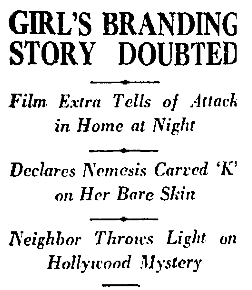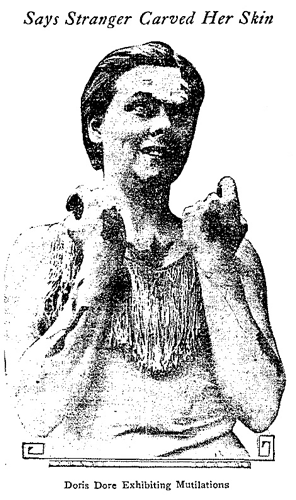She was 52, a mother and grandmother, a vendor of tamales. She lived quietly on the east side of the L.A. River, in an ugly stucco apartment house with concrete all around. Then one Sunday night, as she came home after delivering an order of tamales, she was attacked in the street, stabbed twice and left to die just steps from her home. She was found quickly, but it was too late for any aid. Doña Rosa died, and no one but the killer knew who had done it, or why. Oh, there were rumors, there always are, but for most people on her street, life went on just as it had, just without Doña Rosa’s tasty tamales or her soft smile.
This is not a story from 1927. "Doña" Rosa Cruz, wife of Joel MejÃa, mother of Nancy, native of El Salvador, was murdered in Lincoln Heights on Sunday, July 22. As of today, this crime has received no coverage in the English language newspapers or broadcast media. It has not appeared on the LA Times’ Homicide Report Blog. Detectives were in the neighborhood yesterday, asking questions and looking for an answer. And on the corner of Albion and Avenue 20, the people who loved Doña Rosa continue to gather, bringing fresh flowers and seeking comfort in community, on the open sidewalk where she walked on that last night.
On this blog we remember the forgotten dead from long ago, people who came to Los Angeles and found, not whatever improved life they were seeking, but too often an anonymous or notorious death. We should never forget that these people left families and loved ones, and that these crimes resonate in large ripples out over the decades, in those who knew the victim and far beyond. RIP Doña Rosa, and we hope peace can be found by those who loved her.




 Readers may remember
Readers may remember 
 Which she did, her monkey-man close at heel, and after the show ended, knocked around and did whatever it is young ladies do in Hollywood. Captain of Detectives Slaughter has been busy trying to piece the events of the evening of June 8/early morning of June 9 together: Doris had been out with two married men (now sought for questioning), drinking it up at a local Italian place—she admitted to “feeling pretty good” when she returned but denied that these gents came back to her apartment with her—although other residents had complained to building manager Mrs. A. C. Black that they were disturbed by the loud noise and laughter emanating from within. Doris’ neighbor describes that later, she heard Doris telephone in a local Western Union call: “Come on over in a hurry. Door unlocked.” Said neighbor then recounts assorted door slammings, water runnings, medicine cabinet openings, and: “I heard her put down the folding bed. I next heard her walk out of her apartment and go down the stairs and open the front door. A few minutes later I heard her running very fast back to her apartment. Within a short time I heard a man talking with her. His voice sounded to me like he was angry with her. They remained there for a while and finally went out together. I went back to sleep.”
Which she did, her monkey-man close at heel, and after the show ended, knocked around and did whatever it is young ladies do in Hollywood. Captain of Detectives Slaughter has been busy trying to piece the events of the evening of June 8/early morning of June 9 together: Doris had been out with two married men (now sought for questioning), drinking it up at a local Italian place—she admitted to “feeling pretty good” when she returned but denied that these gents came back to her apartment with her—although other residents had complained to building manager Mrs. A. C. Black that they were disturbed by the loud noise and laughter emanating from within. Doris’ neighbor describes that later, she heard Doris telephone in a local Western Union call: “Come on over in a hurry. Door unlocked.” Said neighbor then recounts assorted door slammings, water runnings, medicine cabinet openings, and: “I heard her put down the folding bed. I next heard her walk out of her apartment and go down the stairs and open the front door. A few minutes later I heard her running very fast back to her apartment. Within a short time I heard a man talking with her. His voice sounded to me like he was angry with her. They remained there for a while and finally went out together. I went back to sleep.”





 Convicted murderer Earl J. Clark was granted a stay of execution today as his appeal twisted its way through the State Supreme Court. There was a time when Clark’s chances to avoid the gallows seemed promising; however, following an escape from prison, things were looking grim.
Convicted murderer Earl J. Clark was granted a stay of execution today as his appeal twisted its way through the State Supreme Court. There was a time when Clark’s chances to avoid the gallows seemed promising; however, following an escape from prison, things were looking grim.
 In July of 1925, Clark was sentenced to hang, but his attorneys immediately initiated an appeal to save his life. The appeal before the State Supreme Court was repeatedly delayed while Clark languished in the Los Angeles County Jail. On March 16, 1926, just days before his appeal was scheduled to come before the court, Clark and five others escaped from jail. While the five were quickly captured, Clark managed to go into hiding for over nine months. He was finally found in Minot, North Dakota, the proprietor of a paint store across the street from the local police station and husband to the daughter of one of Minot’s leading citizens.
In July of 1925, Clark was sentenced to hang, but his attorneys immediately initiated an appeal to save his life. The appeal before the State Supreme Court was repeatedly delayed while Clark languished in the Los Angeles County Jail. On March 16, 1926, just days before his appeal was scheduled to come before the court, Clark and five others escaped from jail. While the five were quickly captured, Clark managed to go into hiding for over nine months. He was finally found in Minot, North Dakota, the proprietor of a paint store across the street from the local police station and husband to the daughter of one of Minot’s leading citizens. 


 On March 28, a dozen witnesses gathered to present inquest testimony. The memories of all and sundry were hazy at best, agreeing that there was bar, chandelier, bottle and window glass involved, table legs used as clubs, and chairs swung with abandon. Members of a Coroner’s jury reached the decision that Diggins had met his death from “a sharp instrument in the hand of a person or persons unknown to us, with homicidal intent,” while an eighth juror agreed with Dennison’s theory, concluding that “the wound was caused by a piece of glass, accidental.” From the morgue he was taken to
On March 28, a dozen witnesses gathered to present inquest testimony. The memories of all and sundry were hazy at best, agreeing that there was bar, chandelier, bottle and window glass involved, table legs used as clubs, and chairs swung with abandon. Members of a Coroner’s jury reached the decision that Diggins had met his death from “a sharp instrument in the hand of a person or persons unknown to us, with homicidal intent,” while an eighth juror agreed with Dennison’s theory, concluding that “the wound was caused by a piece of glass, accidental.” From the morgue he was taken to